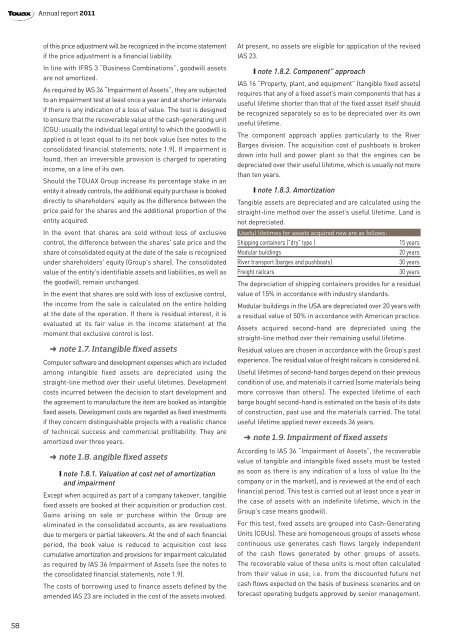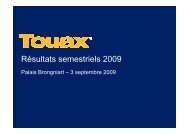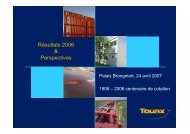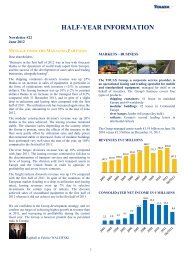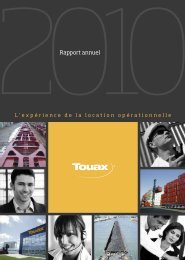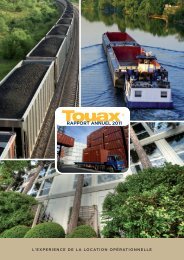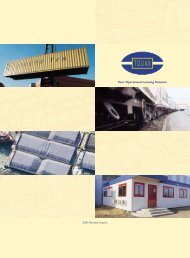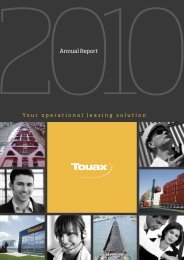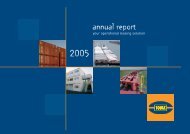2011 Annual report - touax group
2011 Annual report - touax group
2011 Annual report - touax group
You also want an ePaper? Increase the reach of your titles
YUMPU automatically turns print PDFs into web optimized ePapers that Google loves.
<strong>Annual</strong> <strong>report</strong> <strong>2011</strong><br />
of this price adjustment will be recognized in the income statement<br />
if the price adjustment is a financial liability.<br />
In line with IFRS 3 “Business Combinations”, goodwill assets<br />
are not amortized.<br />
As required by IAS 36 “Impairment of Assets”, they are subjected<br />
to an impairment test at least once a year and at shorter intervals<br />
if there is any indication of a loss of value. The test is designed<br />
to ensure that the recoverable value of the cash-generating unit<br />
(CGU: usually the individual legal entity) to which the goodwill is<br />
applied is at least equal to its net book value (see notes to the<br />
consolidated financial statements, note 1.9). If impairment is<br />
found, then an irreversible provision is charged to operating<br />
income, on a line of its own.<br />
Should the TOUAX Group increase its percentage stake in an<br />
entity it already controls, the additional equity purchase is booked<br />
directly to shareholders’ equity as the difference between the<br />
price paid for the shares and the additional proportion of the<br />
entity acquired.<br />
In the event that shares are sold without loss of exclusive<br />
control, the difference between the shares' sale price and the<br />
share of consolidated equity at the date of the sale is recognized<br />
under shareholders' equity (Group's share). The consolidated<br />
value of the entity's identifiable assets and liabilities, as well as<br />
the goodwill, remain unchanged.<br />
In the event that shares are sold with loss of exclusive control,<br />
the income from the sale is calculated on the entire holding<br />
at the date of the operation. If there is residual interest, it is<br />
evaluated at its fair value in the income statement at the<br />
moment that exclusive control is lost.<br />
➜ note 1.7. Intangible fixed assets<br />
Computer software and development expenses which are included<br />
among intangible fixed assets are depreciated using the<br />
straight-line method over their useful lifetimes. Development<br />
costs incurred between the decision to start development and<br />
the agreement to manufacture the item are booked as intangible<br />
fixed assets. Development costs are regarded as fixed investments<br />
if they concern distinguishable projects with a realistic chance<br />
of technical success and commercial profitability. They are<br />
amortized over three years.<br />
➜ note 1.8. angible fixed assets<br />
❙ note 1.8.1. Valuation at cost net of amortization<br />
and impairment<br />
Except when acquired as part of a company takeover, tangible<br />
fixed assets are booked at their acquisition or production cost.<br />
Gains arising on sale or purchase within the Group are<br />
eliminated in the consolidated accounts, as are revaluations<br />
due to mergers or partial takeovers. At the end of each financial<br />
period, the book value is reduced to acquisition cost less<br />
cumulative amortization and provisions for impairment calculated<br />
as required by IAS 36 Impairment of Assets (see the notes to<br />
the consolidated financial statements, note 1.9).<br />
The costs of borrowing used to finance assets defined by the<br />
amended IAS 23 are included in the cost of the assets involved.<br />
At present, no assets are eligible for application of the revised<br />
IAS 23.<br />
❙ note 1.8.2. Component" approach<br />
IAS 16 “Property, plant, and equipment” (tangible fixed assets)<br />
requires that any of a fixed asset’s main components that has a<br />
useful lifetime shorter than that of the fixed asset itself should<br />
be recognized separately so as to be depreciated over its own<br />
useful lifetime.<br />
The component approach applies particularly to the River<br />
Barges division. The acquisition cost of pushboats is broken<br />
down into hull and power plant so that the engines can be<br />
depreciated over their useful lifetime, which is usually not more<br />
than ten years.<br />
❙ note 1.8.3. Amortization<br />
Tangible assets are depreciated and are calculated using the<br />
straight-line method over the asset’s useful lifetime. Land is<br />
not depreciated.<br />
Useful lifetimes for assets acquired new are as follows:<br />
Shipping containers ("dry" type )<br />
15 years<br />
Modular buildings<br />
20 years<br />
River transport (barges and pushboats)<br />
30 years<br />
Freight railcars<br />
30 years<br />
The depreciation of shipping containers provides for a residual<br />
value of 15% in accordance with industry standards.<br />
Modular buildings in the USA are depreciated over 20 years with<br />
a residual value of 50% in accordance with American practice.<br />
Assets acquired second-hand are depreciated using the<br />
straight-line method over their remaining useful lifetime.<br />
Residual values are chosen in accordance with the Group’s past<br />
experience. The residual value of freight railcars is considered nil.<br />
Useful lifetimes of second-hand barges depend on their previous<br />
condition of use, and materials it carried (some materials being<br />
more corrosive than others). The expected lifetime of each<br />
barge bought second-hand is estimated on the basis of its date<br />
of construction, past use and the materials carried. The total<br />
useful lifetime applied never exceeds 36 years.<br />
➜ note 1.9. Impairment of fixed assets<br />
According to IAS 36 “Impairment of Assets”, the recoverable<br />
value of tangible and intangible fixed assets must be tested<br />
as soon as there is any indication of a loss of value (to the<br />
company or in the market), and is reviewed at the end of each<br />
financial period. This test is carried out at least once a year in<br />
the case of assets with an indefinite lifetime, which in the<br />
Group’s case means goodwill.<br />
For this test, fixed assets are <strong>group</strong>ed into Cash-Generating<br />
Units (CGUs). These are homogeneous <strong>group</strong>s of assets whose<br />
continuous use generates cash flows largely independent<br />
of the cash flows generated by other <strong>group</strong>s of assets.<br />
The recoverable value of these units is most often calculated<br />
from their value in use, i.e. from the discounted future net<br />
cash flows expected on the basis of business scenarios and on<br />
forecast operating budgets approved by senior management.<br />
58


